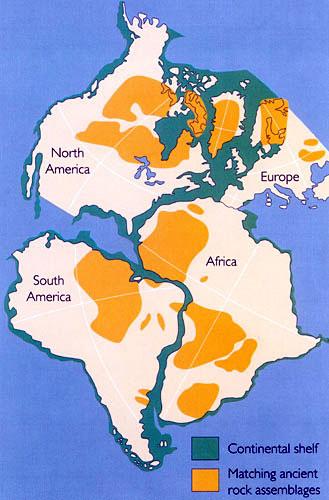Table of Contents
- Unveiling Gaia: Origins and Core Principles
- The Role of Feedback Loops in Gaias Self-Regulation
- Exploring Geological Evidence for Gaias Existence
- Biospheric Interactions and Their Impact on Climate Stabilization
- Future Research Directions in Gaia Hypothesis Validation
- Q&A
- Concluding Remarks
Unveiling Gaia: Origins and Core Principles
The Gaia hypothesis, first proposed by the scientist James Lovelock in the 1970s, offers a revolutionary perspective on Earth’s ecosystems. At its heart, this theory asserts that the Earth functions as a self-regulating system, akin to a super-organism, where the biotic and abiotic elements are intricately linked. This interconnectedness suggests that Earth’s physical and biological components interact closely to maintain conditions conducive to life, such as atmospheric composition, ocean salinity, and climate regulation. These principles challenge conventional understandings of biology and geology, positioning Gaia as both a host and a participant in the dance of life.
Embedded within Gaia’s philosophy is the notion that life shapes the environment and vice versa, forming a symbiotic relationship vital for sustainability. This interplay is evidenced through various natural cycles, such as the carbon, nitrogen, and phosphorus cycles, where living organisms contribute to and rely on these processes. For example, plants absorb carbon dioxide and release oxygen, while decomposers break down organic matter, releasing nutrients back into the soil. These cycles illustrate Earth’s innate ability to balance and adapt to changes, reinforcing the idea of a living, breathing planet.
| Component | Role |
|---|---|
| Oceans | Regulate climate and store carbon |
| Forests | Produce oxygen and support biodiversity |
| Atmosphere | Carries weather patterns and maintains temperature |
The core principles of Gaia are supported by various interdisciplinary studies that highlight nature’s resilience and adaptability. Data from paleoclimatic research, alongside modern climate models, show how life has impacted Earth’s climate over millennia. Moreover, technological advancements in satellite imagery and environmental monitoring have revealed the dynamic interplay between geophysical and biological processes on a global scale. This evidence underscores the hypothesis, prompting a reevaluation of how human activity might destabilize this delicate balance, urging a more sustainable interaction with our planet’s complex systems.

The Role of Feedback Loops in Gaias Self-Regulation
Understanding the intricate tapestry of Earth’s ecosystems requires delving into the significance of feedback mechanisms, which are akin to the whispered conversations of nature itself. These loops can be thought of as nature’s internal checks and balances, seamlessly maintaining harmony amidst the chaos. For instance, the rise in global temperature due to increased CO2 levels leads to more plant growth, absorbing more carbon and eventually cooling the Earth. Such dynamics underscore how Earth’s biological and physical systems are not static but are perpetually adjusting to perturbations.
Feedback loops operate on various scales, from a single biome to the entire planet, continually modulating Earth’s environmental systems. Consider the diminishing Arctic ice caps: as they melt, they expose darker ocean waters, which absorb more sunlight rather than reflecting it, further warming the planet. Similarly, in the plant kingdom, increased levels of atmospheric carbon dioxide can stimulate plant growth, which in return regulates climate by sequestering carbon. These examples highlight how nature’s self-correcting processes drive the Earth’s capacity for resilience and adaptation.
- Positive Feedback: These amplify changes, accelerating environmental transformations, such as the melting ice caps contributing to further warming.
- Negative Feedback: These mitigate fluctuations, steering systems back to stability, evident in Earth’s carbon cycle acting to restore balance.
| Feedback Type | Examples |
|---|---|
| Positive | Melting Ice Caps |
| Negative | Plant Carbon Absorption |

Exploring Geological Evidence for Gaias Existence
Geology offers a fascinating window into the mechanisms that might support the intriguing proposition of a self-regulating Earth, as suggested by the Gaia Hypothesis. One compelling piece of evidence comes from the study of geochemical cycles. These cycles, such as the carbon and sulfur cycles, play a vital role in maintaining Earth’s life-friendly environment. For instance, volcanic activity, a key player in the carbon cycle, contributes to atmospheric CO2 levels, which are critical in regulating global temperatures. Observations reveal that Earth has maintained relatively stable temperatures over geological timescales despite fluctuations in solar output, suggesting some inherent checks and balances are at play.
The distribution and characteristics of sedimentary rock layers are rich in clues about Earth’s past climate and biological activity. These layers act as a historical archive of Earth’s feedback mechanisms. Features like banded iron formations, for example, point to the periods of dramatic change in atmospheric oxygen levels, indicating strong biogeochemical interactions that have evolved over millions of years. Geologists have also studied ancient stromatolites—layered biochemical accretions formed by cyanobacteria—which suggest biological processes have been instrumental in shaping the planet’s environmental conditions since early times.
Beyond these cycles and formations, tectonic activity offers another perspective supporting Gaia. The movement of tectonic plates not only recycles oceanic crust but also redistributes heat and material across the planet. This activity influences the long-term carbon cycle through weathering and subduction processes and affects atmospheric composition. While these processes operate independently of living organisms, the interaction between life forms and geological processes adds a layer of complexity that has supported a stable environment capable of sustaining life. An insightful synthesis of geological data continues to uncover connections between Earth’s physical processes and its biosphere, strengthening the discussion around Earth’s capacity for self-regulation.

Biospheric Interactions and Their Impact on Climate Stabilization
The intricate web of links within our planet’s ecosystems plays a pivotal role in maintaining climatic equilibrium. A core aspect of this is the way that diverse life forms interact with the physical environment, functioning as nature’s own checks and balances. For instance, plants absorb carbon dioxide during photosynthesis, which not only supports the global carbon cycle but also moderates atmospheric temperatures. Additionally, vast networks of fungi and microorganisms work tirelessly in soil to process organic matter, promoting nutrient exchange and climate regulation. These interactions highlight the delicate balance maintained by various biotic and abiotic components, illustrating potential evidence for the Gaia hypothesis.
Within marine environments, the contribution of algae and phytoplankton to climate modulation is profound. These tiny organisms, often overlooked, form the base of aquatic food webs and are instrumental in carbon sequestration processes. They convert carbon dioxide into organic carbon during photosynthesis and influence cloud formation through the release of dimethyl sulfide. This process is paramount in controlling both local and global temperatures. Furthermore, the complex interactions among marine animals, like coral polyps and their symbiotic algae, give rise to ecosystems that significantly stabilize climatic conditions.
- Photosynthesis: Reduces atmospheric carbon dioxide.
- Soil Microorganisms: Enhance nutrient cycling, impacting climate.
- Phytoplankton: Contribute to carbon sequestration and cloud formation.
Terrestrial and aquatic ecosystems are intricately connected through atmospheric and hydrological cycles. The water cycle, for example, is influenced by vegetation that affects evaporation and precipitation patterns. Forests are particularly vital, both in their role as carbon sinks and in local climate regulation through transpiration. In addition, wildlife interactions, such as grazing by herbivores, impact vegetation dynamics and, consequently, the climate. These biospheric interactions emphasize the interdependency between life and the Earth’s regulatory systems, supporting the notion that the planet behaves dynamically like a single, self-regulating organism.

Future Research Directions in Gaia Hypothesis Validation
In the quest to further substantiate the Gaia Hypothesis, future research must pivot toward integrating advanced technological methods with traditional ecological investigations. Satellite imagery technology, for instance, offers the potential to monitor Earth’s ecosystems on a grand scale, providing insights into how these systems self-regulate and interact within the broader context of Earth’s environment. Remote sensing could unravel the subtle yet significant feedback loops that occur at planetary scales, assisting researchers in crafting dynamic models that simulate Earth’s living systems in unprecedented detail.
Collaboration across scientific disciplines is essential to propel this research forward. Leveraging expertise from genetics, climate science, and microbiology alongside geophysics and planetary science can yield comprehensive and integrated insights. Cross-disciplinary research teams could examine how microbial ecosystems contribute to atmospheric regulation, or explore the genetic basis of adaptation in plant and animal populations amid changing environmental conditions. Such studies may uncover evidence of life forms exerting regulatory control to maintain habitability, aligning with the core principles of the hypothesis.
To facilitate a global understanding and validation, there is a need for improved data sharing and access among researchers. Establishing a centralized database that includes extensive ecological and climatic data from multiple regions can enhance the accuracy and reliability of research findings. Below is a simple representation of potential research focus areas:
| Focus Area | Possible Methods |
|---|---|
| Atmospheric Chemistry | Use of Spectral Analysis |
| Oceanic Systems | Remote Sensing Technology |
| Genetic Adaptation | Genomic Sequencing |
By embracing these innovative approaches, the scientific community can move closer to validating the intricacies of life’s role in sustaining Earth’s equilibrium, granting greater empirical support to the hypothesis.



0 Comments